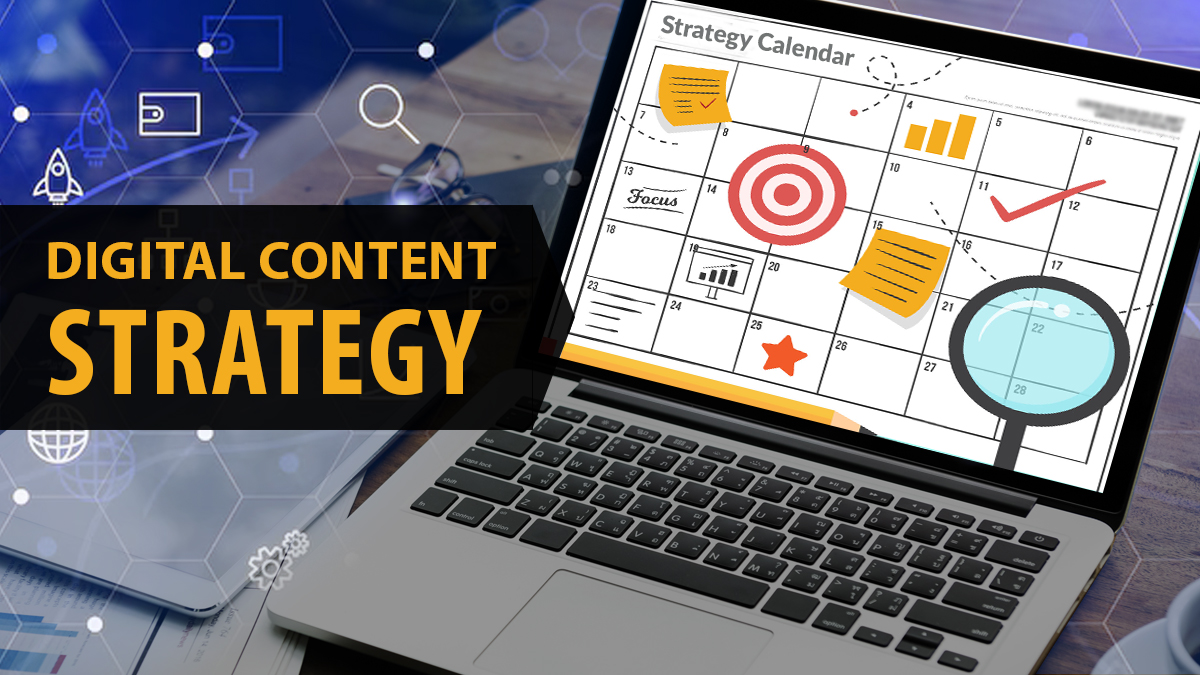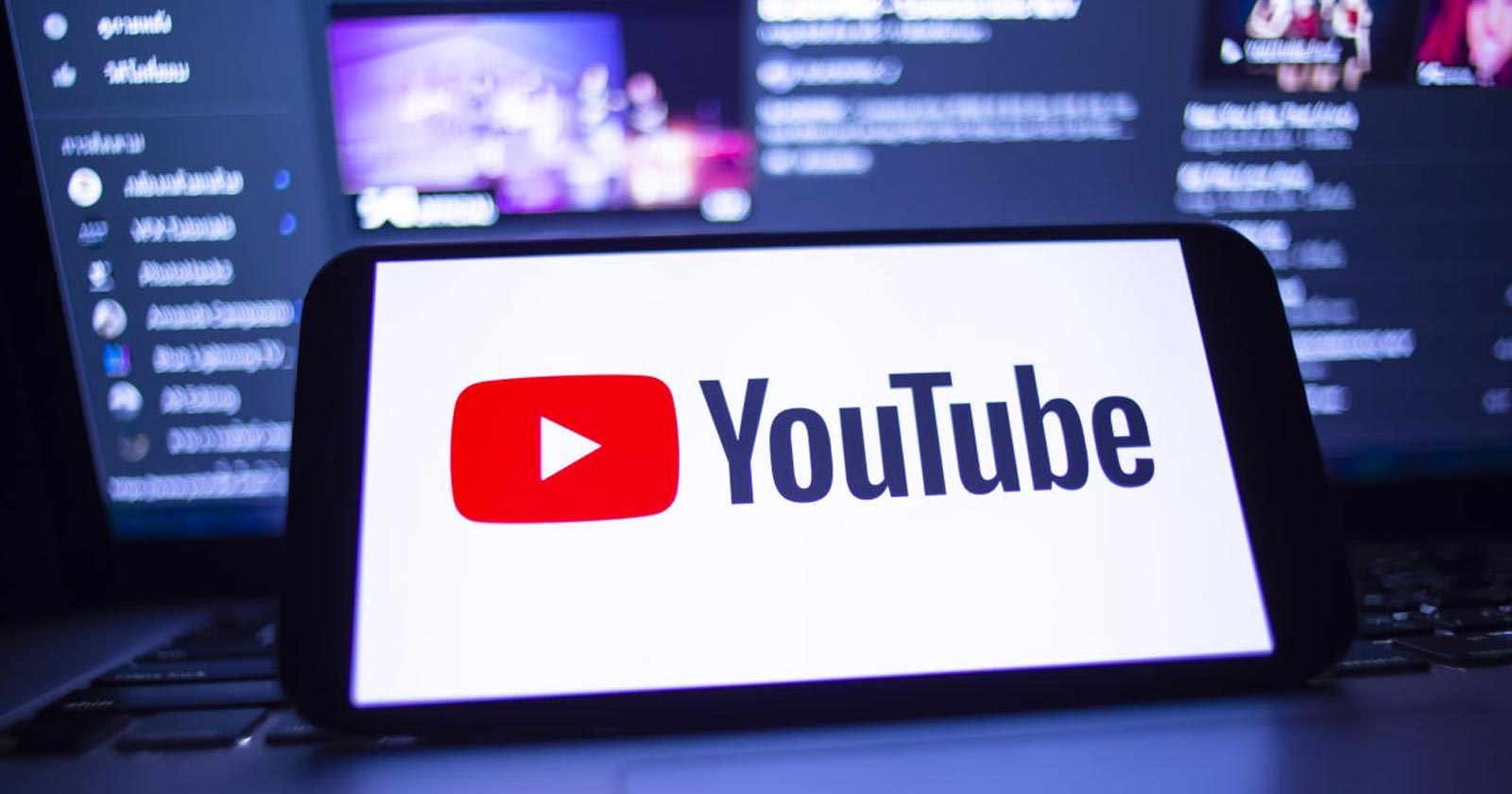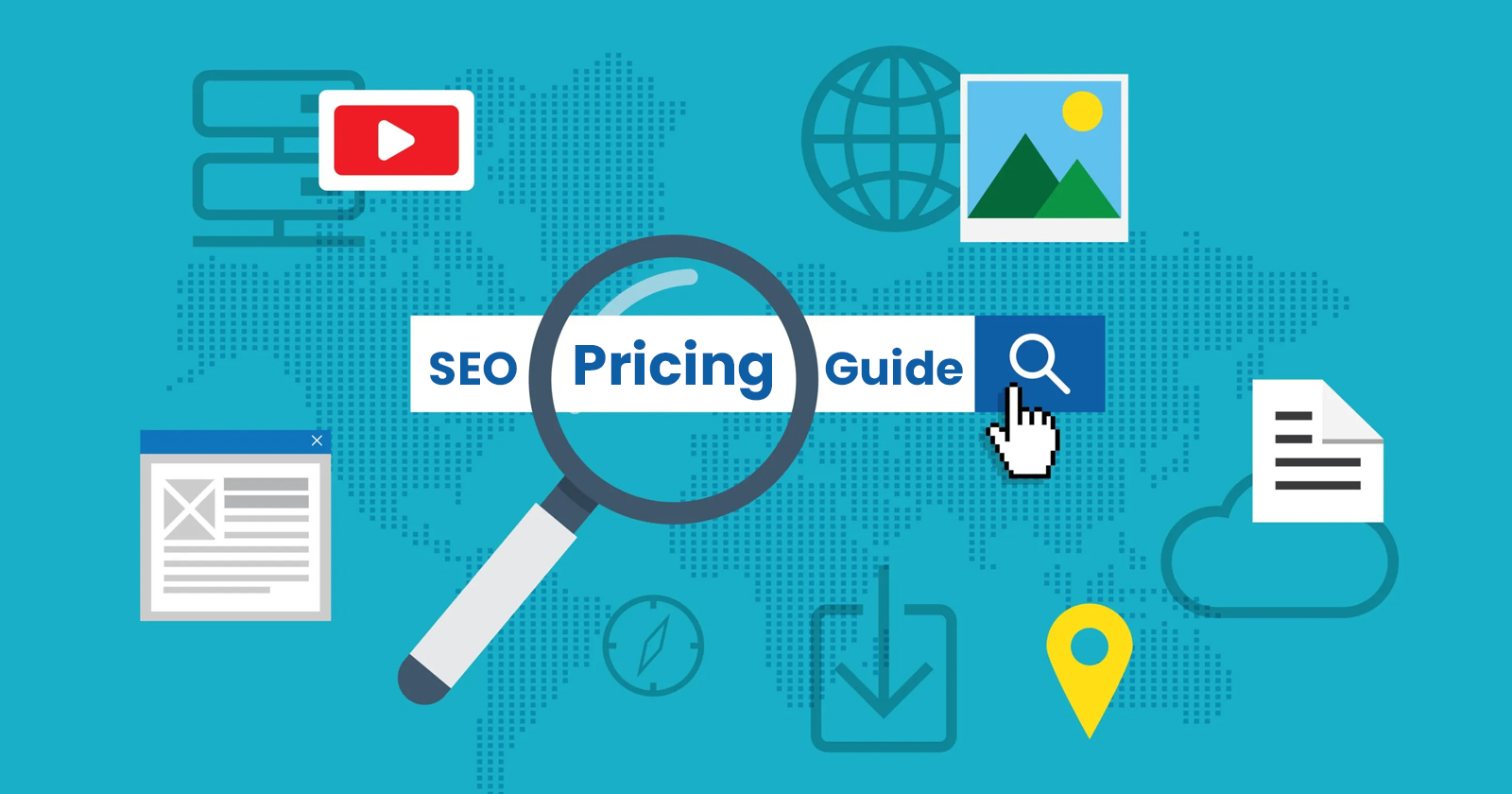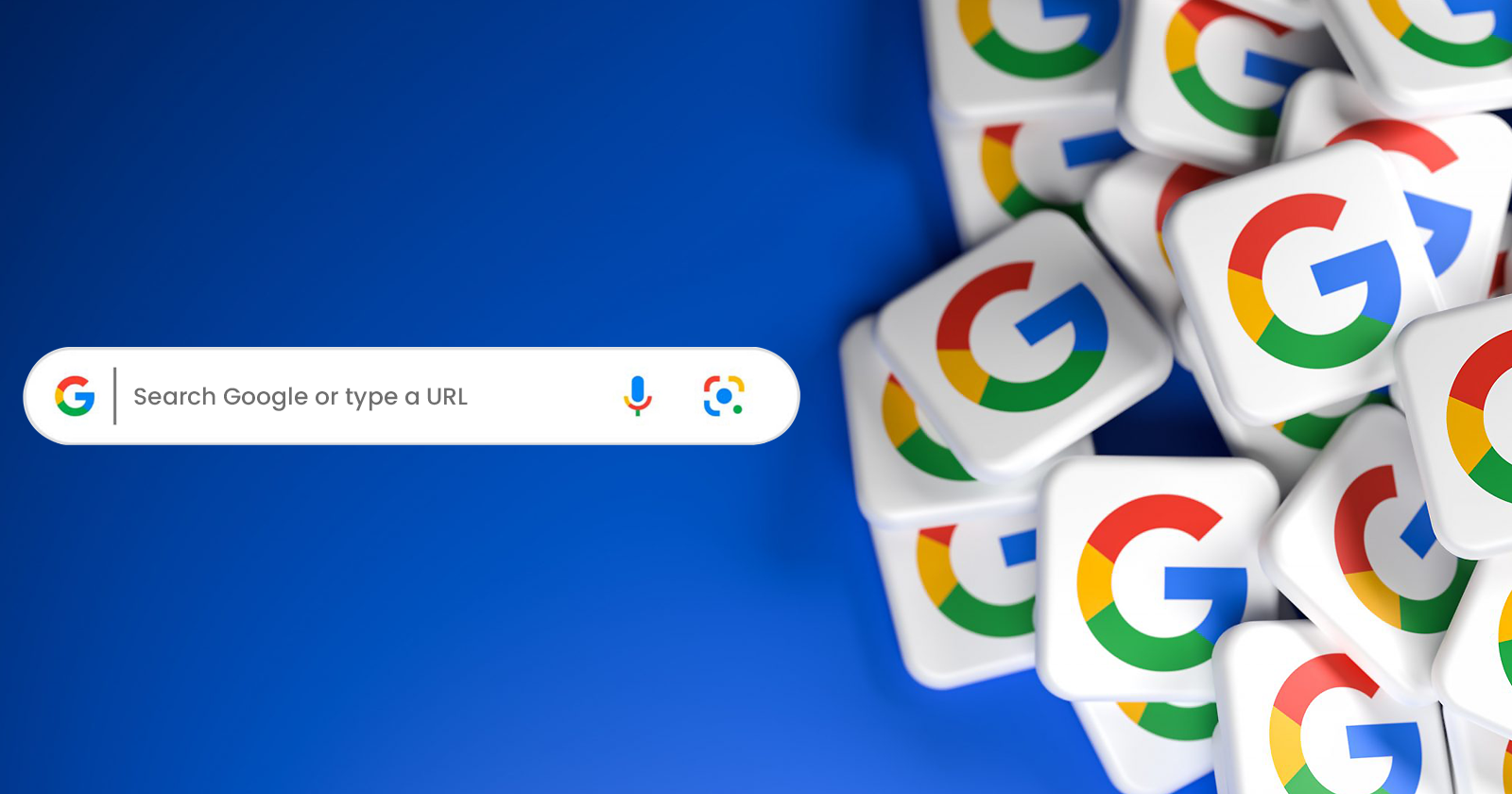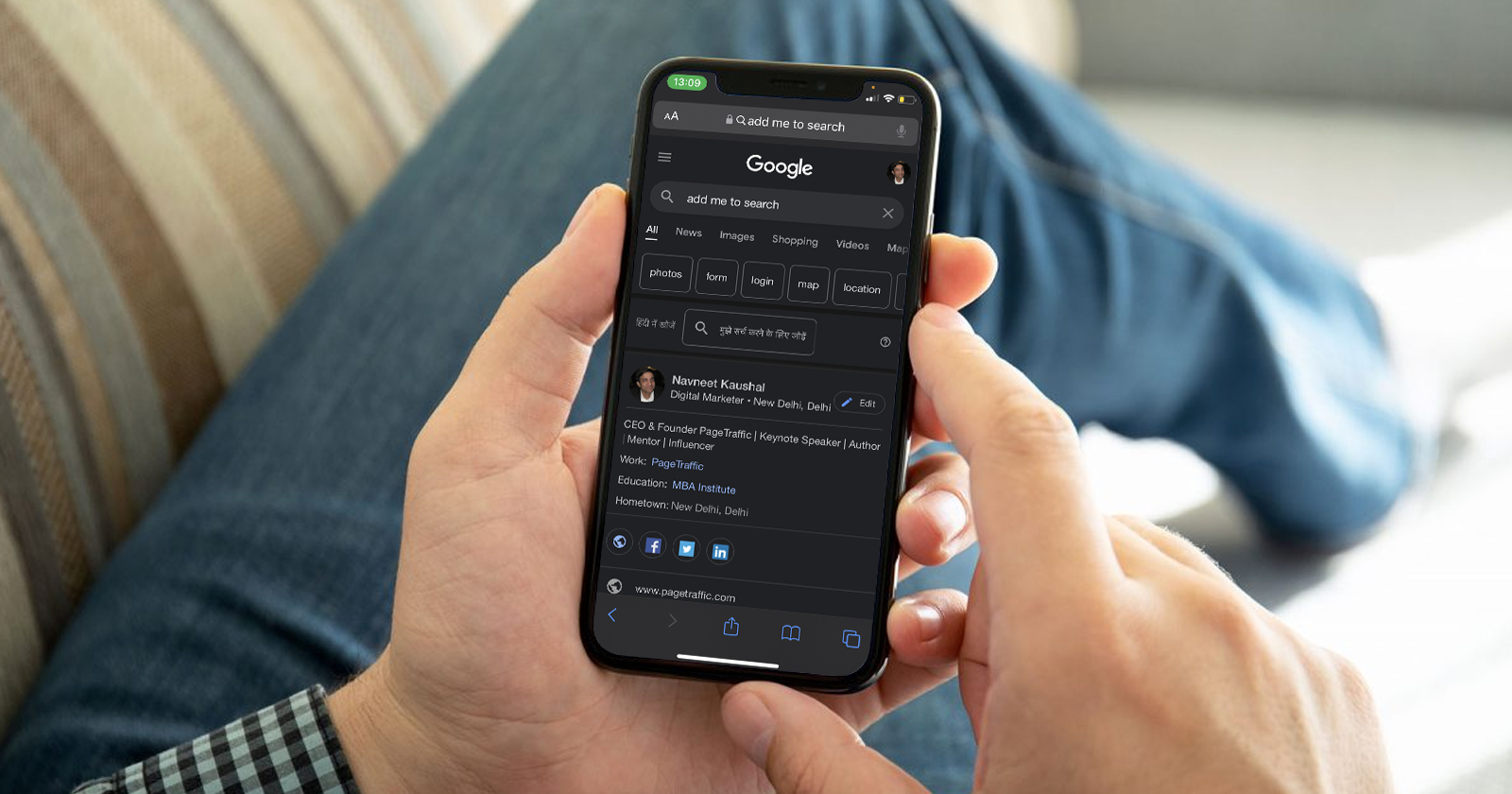Today, in our quick-moving digital world, content is more than just information; it’s an important way to connect, have an impact, and grow. No matter if you’re a business, a nonprofit, or trying to build your personal brand, having a clear and good strategy for your digital content is important to get noticed and connect with your audience.
A digital content strategy is a plan for making, sharing, and handling content that matches your goals and connects with your audience. Without it, efforts usually end up disorganized, uneven, and unproductive.
When you take time to plan carefully, like figuring out what you want to achieve, knowing who your audience is, choosing the best ways to share your content, and checking how well it’s doing, you can make sure your content helps you instead of causing problems.
This post explains the key steps to create a strong digital content strategy based on data. This strategy will help you get good results, increase engagement, and ensure lasting success in the changing online world.
What is a Digital Content Strategy?
A content strategy is a marketing strategy that involves making online content to A) help your audience, and B) reach your business goals. Businesses use content to help them show up more online, make people aware of their brand, and attract new customers.
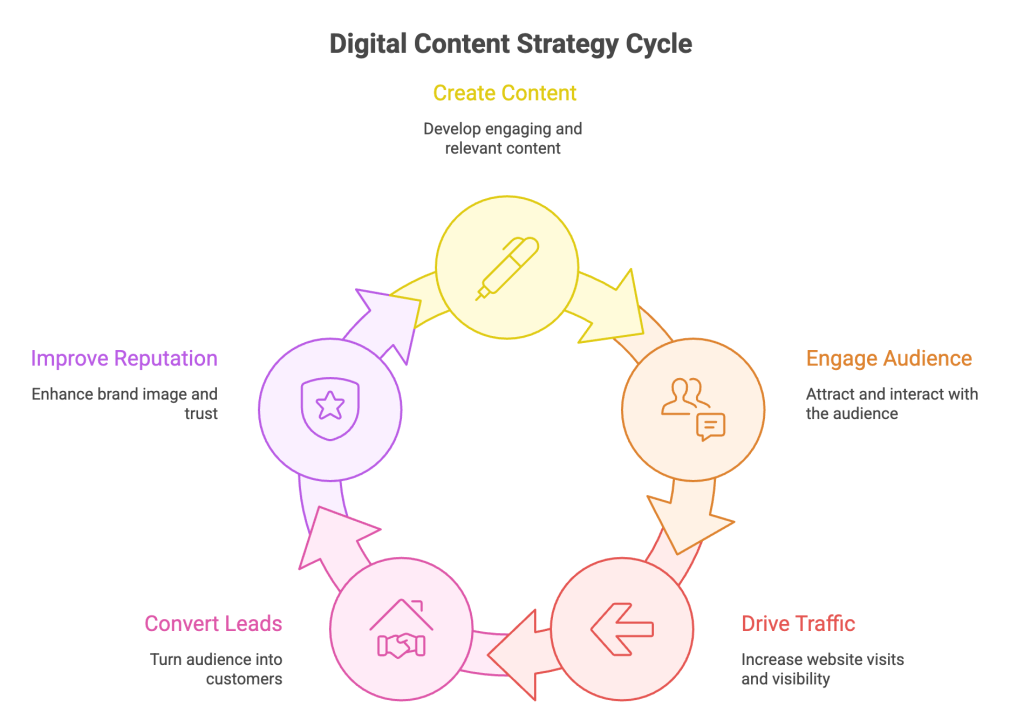
Hiring a full-time content writer is essential for the success of your digital content strategy, ensuring consistent, high-quality output that aligns with your brand voice and engages your target audience.
It includes all types of online marketing, such as social media, search engine optimization, blogging, video marketing, podcasts, and others. The kinds of content used in these strategies are:
- Blog posts
- Podcasts
- Whitepapers
- ebooks
- Social media posts
- Infographics
- Webinars
- Videos
Content creation is a way to bring customers to you instead of chasing them with annoying ads (like stopping someone while they’re watching a video on YouTube). One way to get people to visit your website is by writing blog posts that answer their common questions.
The idea is that when someone types a question into a search engine like Google, they will find one of your blog posts. Another example is turning potential customers into actual buyers by using detailed videos and blog posts that lead to your product pages through buttons that encourage people to take action.
No matter what kind of content you make, the goal is the same: to grow your business and improve your reputation by regularly creating good content that your audience will like.
Why Should You Have a Formal Digital Content Strategy?
A content strategy is not just about making content. It’s about making the kind of content that your audience really wants and that fits with what your business aims to achieve. You could create a blog post that A) answers a question someone is looking for and B) shows them one of your products that can fix their problem for good.
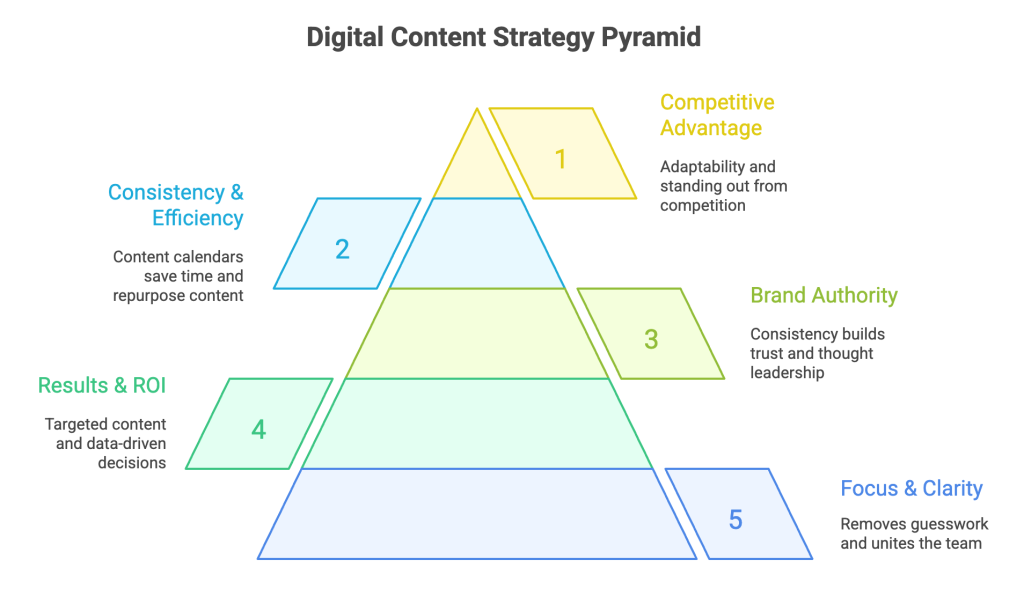
Creating content is a strong method because it helps bring visitors to your website regularly and doesn’t cost a lot of money. If your landing pages are set up to get more people to take action, you’ll increase your sales and get more leads.
But you have to keep things in order, or it will all go wrong. Here are some advantages of creating a detailed strategy for your digital content.
Focus and Clarity
- It removes guesswork
A clear digital content strategy helps everyone understand what to do, so you don’t have to keep guessing. If you don’t have a clear plan, creating content can get messy and confusing. This can lead to misunderstandings in your team and mixed messages for your audience.
With a plan, you understand what to create, when to share it, and who will see it. It also explains what you want to achieve and how your content helps with that. This setup helps you save time and resources, so your team can concentrate on what actually works instead of guessing or trying things out randomly.
- A good strategy brings the team together
When your team follows a common plan for content, everyone understands their jobs, what they’re responsible for, and how their work helps reach the company’s bigger goals. It also helps people communicate better, avoids doing the same work twice, and makes everyone more responsible.
Teams work better together when they follow a clear plan instead of working separately. In the end, a good content strategy helps everyone work together, make better choices, and feel motivated with a common goal in your organization.
Better Results and ROI
- Targeted content
A content strategy helps you make content that is specifically designed for different groups of people, instead of using the same content for everyone. By figuring out who your audience is, how they interact with your content, and what problems they face, you can create messages that really connect with them.
Content aimed at specific people results in more interaction, higher sales, and a stronger bond with your audience. It makes sure that every piece of content, like a blog post, social media update, or video, has a clear goal and is meant for a specific group of people.
- Decisions based on data
With a digital content plan, you can monitor important performance measures and look at the results to see what is working and what isn’t. Instead of trusting your gut feelings or guesses, you use real information, such as how people interact, where they come from, how many take action, and what users do, to help you make choices.
It helps you get better all the time because every piece of content adds to your knowledge. A clear plan helps you set specific goals and use data to improve your methods based on facts, not just guesses.
Also Read: Informational Content: The Key to Engagement (How to Write Them)
Brand Authority
- Being consistent helps build trust
Maintaining the same tone, style, how often you post, and what your message is important for building trust with your audience. When your audience knows what to expect and gets useful information from you often, they’re more likely to trust your business.
Trust is important for good relationships with customers, and confusing messages can quickly damage that trust. Keeping a regular and consistent online presence helps your brand stay in people’s minds, boosts customer loyalty, and makes you look more professional.
- Thought leadership
Be a trusted source of information in your field. Thought leadership blogs are cheap to create and can provide great results. Actually, 55% of brands get new customers from their blogs, and marketers who focus on blogging make 13 times more money in return than those who don’t.
A good content plan makes your brand an expert in your field. By frequently sharing helpful, interesting, and unique information, you show that you know what you’re talking about and build trust. This helps gain trust from customers, friends in the industry, and competitors.
As time goes by, your audience will depend on your content for help, updates, and answers, which will make your influence and reputation stronger. A strategy helps you make sure that your ideas and messages fit well with your brand’s goals. This way, you can influence the conversation in your industry instead of just responding to what’s happening.
Improved Consistency and Efficiency
- Content calendars help you save time
Content calendars are an important part of a digital content plan because they show what to post and when to post it. They help teams plan for the future, make work easier, and avoid rushing at the last minute. With a calendar, you can schedule your content to match important events, product releases, or seasonal changes.
It helps you mix different types of content and platforms, making sure there’s variety and you don’t repeat yourself. When you plan your content ahead of time, your team gets things done faster, meets deadlines better, and feels less stressed. As time goes on, this results in higher-quality content and a more lasting way to create content.
- Repurposing content
A content strategy helps make good use of what you already have by finding ways to reuse it. This means taking one main idea and changing it into different types of content, like turning a blog post into a video, chart, a series of social media posts, or podcast episodes.
Using content again saves time and resources, and helps it reach more people and last longer. It also helps strengthen important messages in various places and ways. With a clear plan, repurposing content is a planned action instead of something done last minute.
Standing Out from the Competition
- Competitive advantage
Having a clear plan for your online content makes you stand out from competitors who create content without a strategy. Your plan helps you stay ahead by spotting trends early, finding what’s missing in the market, and providing better content that meets your audience’s needs.
By being steady, focused, and using data, your content works better to bring in visitors, leads, and sales. A strategy also helps you adjust quickly and deal with changes more wisely. In a busy online world, having a clear content strategy helps your brand stand out.
- Adaptability
No matter if the market changes, the audience acts differently, or new platforms appear, a strategy helps you evaluate, plan, and make changes fast. When you have clear goals and data on how well things are going, you can see what needs to change and make smart choices.
Being flexible is very important in digital marketing because trends and algorithms can change quickly. A strategy helps you adapt while staying on track, making sure your content is relevant, effective, and in line with your brand’s long-term goals.
Also Read: 90 Content Marketing Statistics for 2025
10 Steps to Develop a Digital Content Strategy
It’s definitely not easy to keep making great content for your audience. That’s why you need to understand the main components of a successful content strategy. Whether you have a lot of content already or are just starting to write your first blog, these 10 steps will help you create a content strategy from the beginning.
Step 1: Audit Your Current Content
Before you start, you need to understand your current SEO status. This means checking the content you’ve already published to make sure it’s set up correctly for search engines. You can skip this step if you don’t have any content on your website.
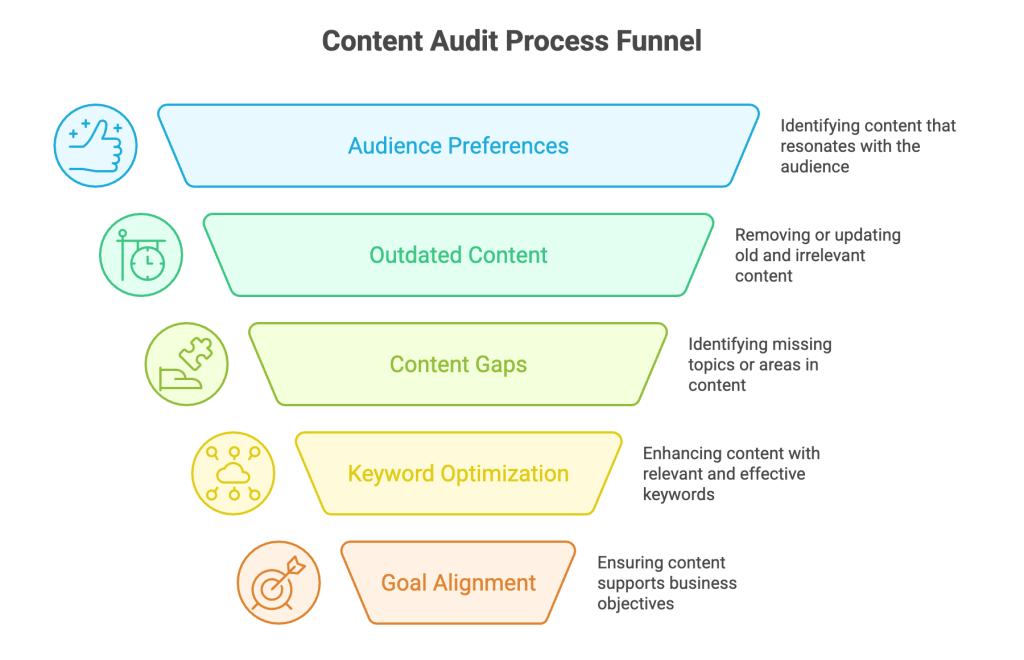
However, it will be useful once you have built up a collection of content, because regular checks are needed for good SEO. Here’s what a complete content review involves:
Know what your audience likes. Looking at your analytics will show you which types of content get the most likes and shares. Write down what your audience likes and try to make more content like that in the future.
Find outdated content. If some of your information is wrong or outdated, it can make things harder for users and hurt your trustworthiness. Make a list of old content that needs to be updated to stay useful.
Look for content gaps. Do you have a variety of content that covers all parts of your business, or are you focusing too much on one subject? Identify the content gap.
Optimize keywords. When you check your content, look at the keywords for each post, if there are any. If your older posts don’t focus on important keywords, change them so they do.
Ensure goal alignment. A content audit will help you see if the content you are making is helping you reach your current goals.
In short, a content audit helps improve your content strategy by finding out what is effective, getting rid of what isn’t, and ensuring all your content pieces fit together well.
Step 2: Set Goals for Your Content
A successful online content strategy starts with clearly knowing what you want to accomplish for your business. Don’t get stuck with unclear goals. Here’s an example of a goal that isn’t clear:
To get better search engine rankings and make more money.
This goal is missing important information, like deadlines and clear targets to achieve. Here’s a better way to say the same thing:
To get into the top 3 for our main keyword and double our income in 10 months.
Now, the goal has some clear details that you can focus on while creating the rest of your strategy. You want to be in the top 3 and double your income, and you have 10 months to achieve that. This will help you understand your content strategy better and provide specific numbers to track how well you’re doing.
Step 3: Create an Avatar of Your Ideal Customer
Next, you need to think like your audience to understand how they shop. How do you do it? The best approach is to make a clear customer avatar (also called a buyer persona). This is a description of a typical person who might buy from you. Your customer profile needs these things:
- Name
- Age
- Job
- Hobbies
- Shopping habits
- Pain points
You can add as much detail as you like to your avatar, including a picture if it helps. A customer avatar helps you figure out what your potential customers want and how they think.
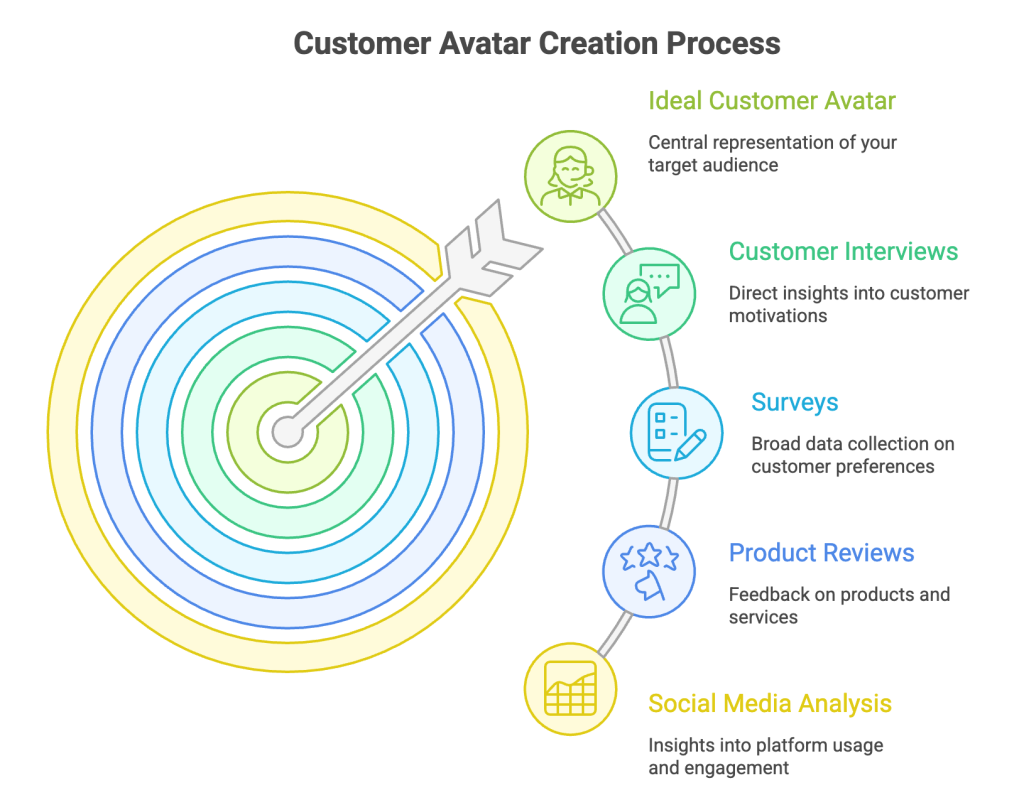
This will make it much easier to come up with useful content ideas that they will like, which will help you reach your content goals. Making a customer profile needs a lot of study. You should read and understand:
Customer interviews. Sit down and chat with your customers to understand what they are thinking. What motivates them to wake up every day? What things drew them to your brand?
Surveys. Customer surveys are a good way to connect with your audience and learn what they like and don’t like.
Product reviews. What do previous customers think about your products and services? Checking outside reviews is a good way to find out more about your audience.
Use information to build your buyer profiles. Social media analysis gives valuable information to help create customer profiles. Facebook Audience Insights is very useful. Google Analytics shows which social media platforms your audience likes best.
This understanding is important because it shows you where to share your content. For example, if your data shows that a lot of people are using LinkedIn, focus on posting your blogs and videos there.
Step 4: Put Together a Team for Content Creation
How do you plan to make all the content you need for your strategy? This is a question you should think about before moving on with your content strategies. You need to figure out how much content you will make on your own, how much your team will make, and how much you will hire freelancers for or use AI to help with.
If you want to try handling some of the work by yourself, do a quick test to see if it fits into your schedule. Creating different types of content takes a lot of time, so be careful. If that’s not the case, think about using services like iWriter and UpWork.
They are great places to find freelancers, such as writers, editors, graphic designers, web developers, and others. You might need to hire people to make videos and edit them, or you can choose to do it yourself.
It’s important to plan how you’ll make your videos before you start filming. This will help you decide if you need a big production setup or if you can just use your iPhone and a simple editing program like Windows Movie Maker.
Sharing content can be hard if you don’t have experience. If you don’t know how to add content to a content management system (like WordPress), you’ll need to hire someone to do it for you.
Step 5: Get the Tools and Resources You Need
A good digital content strategy is not just about the content, but also about using the right tools to make things easier. Here’s what you will need at each step:
| Category | Subcategory | Tools |
| Planning & Setting Goals | Mind Mapping | MindMeister, XMind, Coggle |
| Project Management | Asana, Trello, and Monday.com | |
| Editorial Calendars | CoSchedule, Google Sheets/Calendar, Airtable | |
| Research & Analysis | Competitor Analysis | BuzzSumo, SimilarWeb, SpyFu |
| Keyword Research | SEMrush, Google Keyword Planner, Ahrefs | |
| Audience Insights | Facebook Audience Insights, Google Analytics, and Sprout Social | |
| Content Creation | Video Production | Adobe Premiere Pro, Final Cut Pro, iMovie, Kapwing |
| Graphic Design | Canva, Adobe Creative Suite, Visme | |
| Writing and Editing | Microsoft Word, Google Docs, Grammarly, ProWritingAid | |
| CMS | WordPress, Squarespace, Wix, Drupal, and Joomla | |
| Audio Production | Audacity, GarageBand, Adobe Audition | |
| Promotion & Distribution | Email Marketing | Hubspot, Mailchimp, ConvertKit, ActiveCampaign |
| Social Media Management | Hootsuite, Sprout Social, Buffer | |
| Content Syndication | Medium, LinkedIn Pulse | |
| Measurement & Analytics | Social Media Analytics | Built-in analytics in Facebook, X, LinkedIn |
| Website Analytics | Google Analytics | |
| SEO Tools | SEMrush, Ahrefs, Moz |
Making content using tools can be expensive, so you should figure out how much money you can spend. Tools for email marketing, like Hubspot, and SEO analysis can get expensive fast.
Before you spend more money than you can handle, think about the costs of tools and hiring freelancers. This way, you will always know how much money you are spending and what you are buying.
Step 6: Perform Keyword Research for SEO
Once you have your team and tools ready, it’s time to start looking up keywords. This is important not just for SEO, but also to help shape your content strategy. Keywords or search queries are the words that your audience types into search engines to look for information about products and services that you offer.
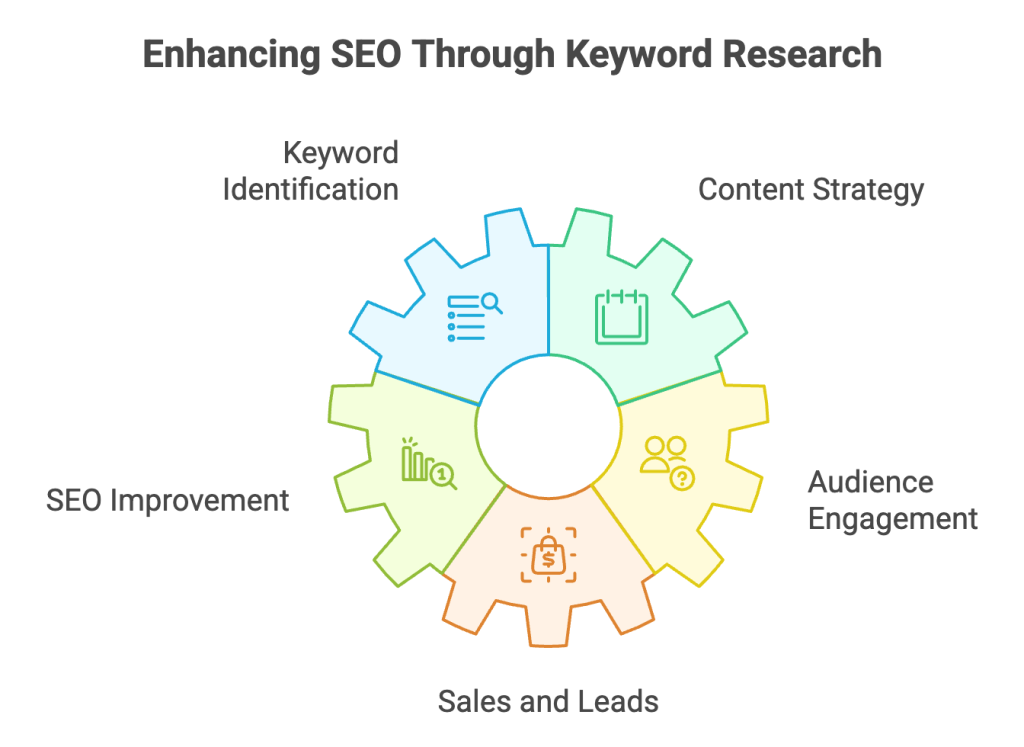
By finding and focusing on these keywords, you’ll not only catch the attention of search engines, but you’ll also gain a clearer idea of what your audience wants to see. It’s useful to think of an example, so let’s say you sell gym equipment on the internet.
After using a keyword planner tool, you find the long-tail keyword “exercise bike”. It gets a lot of searches and is becoming more popular, so getting a good position for it will help improve your website’s SEO.
Also, the keyword gives you a clue about what kind of content you should create. Since many people want to buy an exercise bike, it would be a good idea to create a how-to assemble guide or tutorial, either as a video or a blog post.
Ideally, your content will start bringing in visitors who want to learn how to maintain their exercise bikes the right way. With a good call-to-action or free offer, this useful guide will help you start making sales and getting more leads for your business.
That’s a simple and hopeful explanation of keyword research, but the main idea is clear. You should find popular keywords in your area to make content, and free keyword tools can help you do this.
Step 7: Think of Content ideas for Your Keywords
Once you have two to three keywords for your content, you can begin coming up with ideas for it. Look at what the keyword really means, because it will help you know what kind of content to make.
Is it meant to share information? If yes, then think about using blog posts, guides, and how-to articles. If it’s for a commercial purpose, product reviews and free demonstrations are the best options.
In the end, you get to choose what to make, but you should make your choices based on your research. Imagine you have a store that sells gym equipment, and you want to advertise your dumbbells.
If you check a keyword planner, you might feel a bit discouraged at first because the phrase “dumbbell price” looks like it’s becoming less popular. But there’s some good news: “rubber dumbbells” is becoming more popular.
This means the user is looking at different gym equipment, and if your content is good enough, you could get them to make a purchase.
Ideas for Content
Blog: A blog post called “How to Find the Best Dumbbells for Your Exercise Routine?” is great for this keyword. Check out a variety of well-known tools, including yours. Call-out boxes and an attractive call to action help to showcase your product effectively.
Video demo: Think about making a short video showing how well your gym equipment works and what makes it special. Post it on YouTube and social media where people look for how-to guides.
Infographic: Make a colorful picture that shows and compares different types of dumbbells, like vinyl, cast iron, and rubber. Add the pros and cons of each type, and explain the best ways to use them, while also gently pointing out the strengths of your own product.
Takeaway: Use popular keywords to help decide what kind of content to create. Focus on understanding what people are looking for when they search. This way, your content can meet their needs.
Other things to think about:
Audience: Consider the age of the people you want to reach, how they use the internet, and which sites or apps they like best. Younger people might like short, fun videos on TikTok more than reading blog posts on LinkedIn, which are better for business decision-makers.
Goals: Are you trying to get people to know your brand, teach them about your product, or make direct sales? This will affect what kind of content you create.
Repurposing: Can one main piece of content (like a blog post) be changed into social media posts, a short video, or a picture with information?
Experiment: Don’t worry about trying new styles. Watching how people engage helps you make better choices as time goes on.
Step 8: Make a RoadMap for Your Content
By now, you should have a list of important words and related ideas for your content. But you still need to strategy how to achieve success using a content roadmap. A content roadmap is a clear, visual strategy showing what content you strategy to create and when.
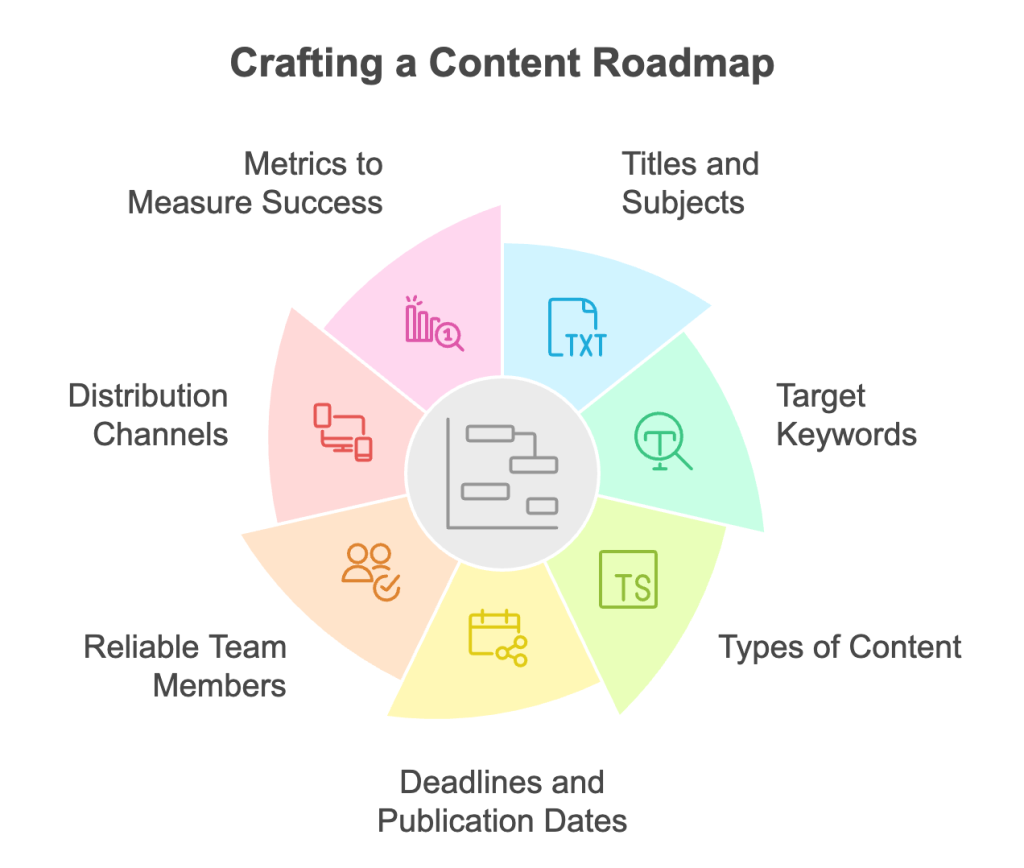
It’s a main document that helps you strategy your content strategy. It’s not just a list of topics you want to talk about; it updates and changes as you work. A content roadmap is often a simple table that includes these things:
- Titles and subjects of content
- Target keywords
- Types of content
- Deadlines and publication dates
- Reliable team members
- Distribution channels
- Metrics to measure success
Why is a roadmap for content important?
Alignment: A content roadmap helps make sure that everything you create helps achieve your main business goals. It helps your team members focus on the same goals, which is good.
Organization: Content maps help decrease confusion, which many organizations already have a lot of. It also helps organize content planning, gives out tasks, and keeps things on track.
Accountability: The map shows who is responsible for each piece of content and when it is due. This makes your team accountable for their work and ensures on time completion.
Adaptability: A roadmap gives you a strategy, but it also lets you be flexible. You can change things based on how people respond.
Long-term strategy: A content roadmap shows you the overall strategy and helps you find missing parts or repeated content in your schedule.
You should include both long-lasting topics and current topics to get the best results. Your evergreen content will keep working for you, while your timely articles will help you take advantage of big increases in visitors when you write about trending topics.
What is evergreen content?
It’s a type of information that won’t become outdated, so what it says will always be correct. Some examples are:
- Tutorials
- Testimonials
- How to guides
- FAQs
These topics don’t have a time limit, so if you can attract visitors and potential customers with them, they will keep bringing in results for months and even years. If you only make content that stays relevant forever, you might miss out on traffic spikes, which could mean losing chances to earn money and increase your brand’s visibility.
When planning your posting schedule, make sure to blog at least 2 to 4 times a week to get the best results. You should also consider special holidays that are important to your audience. Creating content about these events can help you get more visitors and build a loyal group of followers.
Step 9: Create and Publish Your Content
Now that you’ve finished all the preparation, you can start making and publishing your own content. As you go, watch your project management tools to make sure everything is going well. Make sure your content team knows when each piece is due so everything goes well. Also, try your best to give them extra information like outlines, style guides, and clear instructions.
Step 10: Monitor Your Progress and Analyze Data
Even though content marketing and SEO take time to show results, you should start tracking important numbers and performance indicators right away. That means looking at Google Analytics to keep track of your search rankings, website visitors, and how many people are taking action on your site. If you don’t get the results you want in a few months, it’s time to rethink your strategy and try a different approach.
Mistakes to Avoid in Your Digital Content Strategy
Quantity Over Quality
Some website owners want to put a lot of content on their sites, but this makes them focus more on having a lot instead of good quality. However, this is a mistake because low-quality content weakens the brand message, doesn’t capture readers’ interest, and lowers search rankings. Take your time and focus on making fewer but better quality content instead of rushing to create a lot of AI-generated content.
Ignoring SEO
Making content isn’t just about giving value to your audience (even though that should be your main goal). SEO is important, so you shouldn’t ignore its role in your work. This means you need to do detailed keyword research, set up your website correctly, and get valuable links from reliable sites.
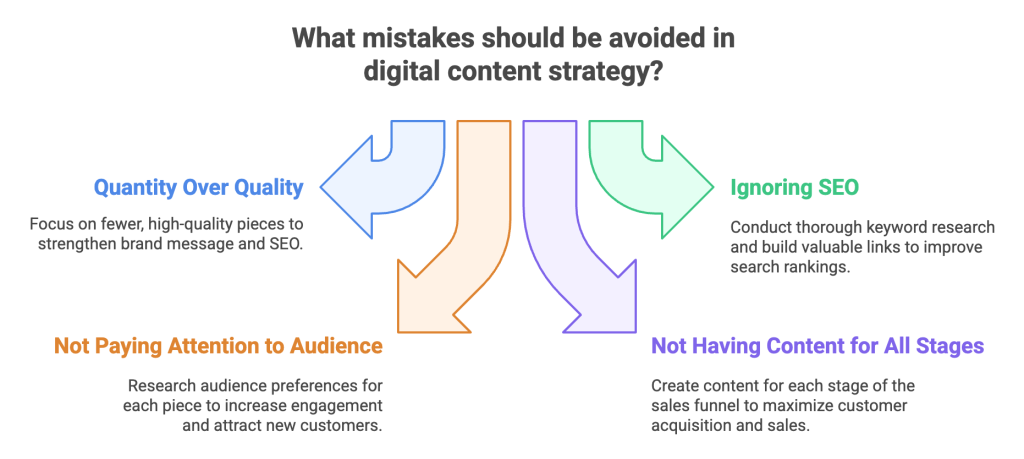
Not Paying Attention to Your Audience
Don’t make content just because you think that’s what your audience wants. Even if you know your audience well, you still need to do research for every piece of content to make sure it works. If you don’t do this, you might get less involvement from people, miss chances to attract new customers, and create a gap between your brand and potential buyers.
Not Having Content for All Stages of the Sales Funnel
Content is very important at every stage of a buyer’s journey, so you shouldn’t only pay attention to one part of the sales funnel. Why is that so? Focusing only on one step will make you miss chances to find new customers and make sales.
For example, some businesses only make content for potential customers who are ready to buy. This type of content is designed to help make a sale. Getting conversions is always good, but this method doesn’t help people who aren’t ready to buy right away.
That’s why you should create content for every step of your sales process. Each stage provides you different opportunities to connect with your audience. Here’s a simple explanation of what that means:
TOFU (top-of-the-funnel): At this stage, the person is looking for information to learn something or answer a question. Content types include helpful blog posts, videos, and visual charts.
MOFU (middle-of-the-funnel): At this stage, the potential customer wants to find out more about what you offer. The types of content for this stage are product videos, helpful emails, eBooks, and online seminars.
BOFU (bottom-of-the-funnel): This is when a potential buyer is ready to buy. You just need to show them that you are the best choice. This content includes positive reviews and testimonials, videos that show how the product works, and blog posts that connect to product pages.
By knowing what potential customers need at different points, you can connect with all your prospects, not just those who are searching for information or ready to buy.
Wrapping Up
Making a digital content plan isn’t just about posting often or keeping up with trends. It’s about creating a clear and meaningful plan that matches your brand’s goals and meets the needs of your audience.
By using a clear plan that includes setting goals, researching your audience, planning your content, choosing the right channels, and tracking how well you’re doing, you can build a strong base for long-lasting growth online.
A good content plan helps you reach more people and make a bigger impact. It also makes sure that every piece of content has a clear purpose and helps you achieve your main goals.
In a busy online world, being clear, steady, and creative really matters. A good digital content plan helps you share your story clearly, build better relationships, and achieve important results as time goes on.
FAQs
Why is it important to identify your target audience?
Knowing who your audience is very important because it helps you make content that they will like and find useful. Understanding your audience helps you adjust your message, tone, and style to connect with them better. It also helps get more people to take action, making sure your content is seen by the right audience. By looking at who their customers are, what they do, and what problems they face, businesses can create tailored content that builds trust and loyalty.
How to do goal setting for my digital content strategy?
Set goals such as getting more people to know about your brand, attracting visitors to your website, finding potential customers, or getting more interaction on social media. Use measurements like how many people click links, how many take action, and how long the audience stays to see how you’re doing. Goals should be SMART: specific, measurable, achievable, relevant, and time-bound. This helps create a clear plan for putting the content strategy into action.
How does a content calendar help in strategizing content?
A content calendar helps plan and schedule what to share, making sure it’s posted regularly and keeps people interested. Businesses can use content calendars to mix up different types of content, avoid repeating the same things, and make their work process smoother. A well-organized calendar helps teams work together better and keeps everyone updated on time. By planning in advance, marketers can improve the quality of their work, choose the best times to engage with people, and create excitement among their audience.
What is the importance of analytics in content strategy?
Analytics gives businesses information about how their content is doing. It helps them understand how their audience behaves, how much they interact with the content, and how many people take action after seeing it. Numbers like how many times a page is viewed, how often people click on links, likes and shares on social media, and how long people stay on a page show what content people like. By looking at patterns, companies can change their plans to be more successful.
How often should I change my digital content strategy?
A digital content plan should be checked and updated often to keep up with new trends, what the audience likes, and how well it’s doing. Changes in the market, updates to SEO rules, and what the audience says should help you make changes. Updating content regularly keeps it interesting and helps keep people involved. Companies that change with the times in the digital world stay competitive and keep their plans working well. Learning and improving all the time bring lasting success.
